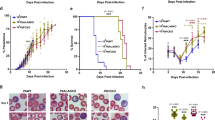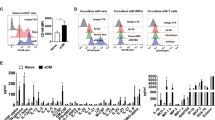Abstract
Cerebral malaria claims more than 1 million lives per year. We report that heme oxygenase-1 (HO-1, encoded by Hmox1) prevents the development of experimental cerebral malaria (ECM). BALB/c mice infected with Plasmodium berghei ANKA upregulated HO-1 expression and activity and did not develop ECM. Deletion of Hmox1 and inhibition of HO activity increased ECM incidence to 83% and 78%, respectively. HO-1 upregulation was lower in infected C57BL/6 compared to BALB/c mice, and all infected C57BL/6 mice developed ECM (100% incidence). Pharmacological induction of HO-1 and exposure to the end-product of HO-1 activity, carbon monoxide (CO), reduced ECM incidence in C57BL/6 mice to 10% and 0%, respectively. Whereas neither HO-1 nor CO affected parasitemia, both prevented blood-brain barrier (BBB) disruption, brain microvasculature congestion and neuroinflammation, including CD8+ T-cell brain sequestration. These effects were mediated by the binding of CO to hemoglobin, preventing hemoglobin oxidation and the generation of free heme, a molecule that triggers ECM pathogenesis.
This is a preview of subscription content, access via your institution
Access options
Subscribe to this journal
Receive 12 print issues and online access
$209.00 per year
only $17.42 per issue
Buy this article
- Purchase on Springer Link
- Instant access to full article PDF
Prices may be subject to local taxes which are calculated during checkout






Similar content being viewed by others
References
Francis, S.E., Sullivan, D.J., Jr. & Goldberg, D.E. Hemoglobin metabolism in the malaria parasite Plasmodium falciparum. Annu. Rev. Microbiol. 51, 97–123 (1997).
Balla, J. et al. Heme, heme oxygenase and ferritin in vascular endothelial cell injury. Mol. Nutr. Food Res. 49, 1030–1043 (2005).
Orjih, A.U., Banyal, H.S., Chevli, R. & Fitch, C.D. Hemin lyses malaria parasites. Science 214, 667–669 (1981).
Balla, G. et al. Ferritin: a cytoprotective antioxidant strategem of endothelium. J. Biol. Chem. 267, 18148–18153 (1992).
Tenhunen, R., Marver, H.S. & Schmid, R. The enzymatic conversion of heme to bilirubin by microsomal heme oxygenase. Proc. Natl. Acad. Sci. USA 61, 748–755 (1968).
Sato, K. et al. Carbon monoxide generated by heme oxygenase-1 suppresses the rejection of mouse to rat cardiac transplants. J. Immunol. 166, 4185–4194 (2001).
Otterbein, L.E., Soares, M.P., Yamashita, K. & Bach, F.H. Heme oxygenase-1: unleashing the protective properties of heme. Trends Immunol. 24, 449–455 (2003).
Clark, I.A., Cowden, W.B. & Rockett, K.A. The pathogenesis of human cerebral malaria. Parasitol. Today 10, 417–418 (1994).
Schofield, L. & Grau, G.E. Immunological processes in malaria pathogenesis. Nat. Rev. Immunol. 5, 722–735 (2005).
Lou, J., Lucas, R. & Grau, G.E. Pathogenesis of cerebral malaria: recent experimental data and possible applications for humans. Clin. Microbiol. Rev. 14, 810–820 (2001).
Hansen, D.S., Siomos, M.A., Buckingham, L., Scalzo, A.A. & Schofield, L. Regulation of murine cerebral malaria pathogenesis by CD1d-restricted NKT cells and the natural killer complex. Immunity 18, 391–402 (2003).
Basilico, N., Monti, D., Olliaro, P. & Taramelli, D. Non-iron porphyrins inhibit beta-haematin (malaria pigment) polymerisation. FEBS Lett. 409, 297–299 (1997).
Yamashita, K. et al. Biliverdin, a natural product of heme catabolism, induces tolerance to cardiac allografts. FASEB J. 18, 765–767 (2004).
Favre, N. et al. Role of ICAM-1 (CD54) in the development of murine cerebral malaria. Microbes Infect. 1, 961–968 (1999).
Thumwood, C.M., Hunt, N.H., Clark, I.A. & Cowden, W.B. Breakdown of the blood-brain barrier in murine cerebral malaria. Parasitology 96, 579–589 (1988).
Good, M.F., Xu, H., Wykes, M. & Engwerda, C.R. Development and regulation of cell-mediated immune responses to the blood stages of malaria: implications for vaccine research. Annu. Rev. Immunol. 23, 69–99 (2005).
Grau, G.E. et al. Tumor necrosis factor (cachectin) as an essential mediator in murine cerebral malaria. Science 237, 1210–1212 (1987).
Engwerda, C.R. et al. Locally up-regulated lymphotoxin alpha, not systemic tumor necrosis factor alpha, is the principle mediator of murine cerebral malaria. J. Exp. Med. 195, 1371–1377 (2002).
Grau, G.E. et al. Monoclonal antibody against interferon gamma can prevent experimental cerebral malaria and its associated overproduction of tumor necrosis factor. Proc. Natl. Acad. Sci. USA 86, 5572–5574 (1989).
Belnoue, E. et al. On the pathogenic role of brain-sequestered alphabeta CD8+ T cells in experimental cerebral malaria. J. Immunol. 169, 6369–6375 (2002).
Yanez, D.M., Manning, D.D., Cooley, A.J., Weidanz, W.P. & van der Heyde, H.C. Participation of lymphocyte subpopulations in the pathogenesis of experimental murine cerebral malaria. J. Immunol. 157, 1620–1624 (1996).
Balla, J. et al. Endothelial-cell heme uptake from heme proteins: induction of sensitization and desensitization to oxidant damage. Proc. Natl. Acad. Sci. USA 90, 9285–9289 (1993).
Berendt, A.R., Tumer, G.D. & Newbold, C.I. Cerebral malaria: the sequestration hypothesis. Parasitol. Today 10, 412–414 (1994).
Reiter, C.D. et al. Cell-free hemoglobin limits nitric oxide bioavailability in sickle-cell disease. Nat. Med. 8, 1383–1389 (2002).
Gramaglia, I. et al. Low nitric oxide bioavailability contributes to the genesis of experimental cerebral malaria. Nat. Med. 12, 1417–1422 (2006).
Bouton, C. & Demple, B. Nitric oxide-inducible expression of heme oxygenase-1 in human cells. Translation-independent stabilization of the mRNA and evidence for direct action of nitric oxide. J. Biol. Chem. 275, 32688–32693 (2000).
Clark, A.R., Dean, J.L. & Saklatvala, J. Post-transcriptional regulation of gene expression by mitogen-activated protein kinase p38. FEBS Lett. 546, 37–44 (2003).
Schluesener, H.J., Kremsner, P.G. & Meyermann, R. Heme oxygenase-1 in lesions of human cerebral malaria. Acta Neuropathol. (Berl.) 101, 65–68 (2001).
Grau, G.E. et al. Tumor-necrosis-factor (cachectin) as an essential mediator in murine cerebral malaria. Science 237, 1210–1212 (1987).
McGuire, W., Hill, A.V.S., Allsopp, C.E.M., Greenwood, B.M. & Kwiatkowski, D. Variation in the Tnf-alpha promoter region associated with susceptibility to cerebral malaria. Nature 371, 508–511 (1994).
Grau, G.E. et al. Tumor necrosis factor and disease severity in children with falciparum-malaria. N. Engl. J. Med. 320, 1586–1591 (1989).
Wilson, A.G., Symons, J.A., McDowell, T.L., McDevitt, H.O. & Duff, G.W. Effects of a polymorphism in the human tumor necrosis factor alpha promoter on transcriptional activation. Proc. Natl. Acad. Sci. USA 94, 3195–3199 (1997).
Grau, G.E. et al. Late administration of monoclonal-antibody to leukocyte function-antigen 1 abrogates incipient murine cerebral malaria. Eur. J. Immunol. 21, 2265–2267 (1991).
Ockenhouse, C.F. et al. Human vascular endothelial-cell adhesion receptors for plasmodium-falciparum infected erythrocytes: roles for endothelial leukocyte adhesion molecule-1 and vascular cell-adhesion molecule-1. J. Exp. Med. 176, 1183–1189 (1992).
Hunt, N.H. & Grau, G.E. Cytokines: accelerators and brakes in the pathogenesis of cerebral malaria. Trends Immunol. 24, 491–499 (2003).
Exner, M., Minar, E., Wagner, O. & Schillinger, M. The role of heme oxygenase-1 promoter polymorphisms in human disease. Free Radic. Biol. Med. 37, 1097–1104 (2004).
Takeda, M. et al. Microsatellite polymorphism in the heme oxygenase-1 gene promoter is associated with susceptibility to cerebral malaria in Myanmar. Jpn. J. Infect. Dis. 58, 268–271 (2005).
Bach, F.H., Hancock, W.W. & Ferran, C. Protective genes expressed in endothelial cells: a regulatory response to injury. Immunol. Today 18, 483–486 (1997).
Nathan, C. Points of control in inflammation. Nature 420, 846–852 (2002).
Yet, S.F. et al. Hypoxia induces severe right ventricular dilatation and infarction in heme oxygenase-1 null mice. J. Clin. Invest. 103, R23–R29 (1999).
Franke-Fayard, B. et al. A Plasmodium berghei reference line that constitutively expresses GFP at a high level throughout the complete life cycle. Mol. Biochem. Parasitol. 137, 23–33 (2004).
Otterbein, L.E. et al. Carbon monoxide has anti-inflammatory effects involving the mitogen-activated protein kinase pathway. Nat. Med. 6, 422–428 (2000).
van der Heyde, H.C. et al. Assessing vascular permeability during experimental cerebral malaria by a radiolabeled monoclonal antibody technique. Infect. Immun. 69, 3460–3465 (2001).
Acknowledgements
We thank S.-F. Yet (Pulmonary and Critical Care Division, Brigham and Women's Hospital) for providing the original Hmox1 mouse breeding pairs from which all Hmox1−/− used in this study were derived. We also thank A. Rodriguez, F. Bach, T. Pais and C. Gregoire for critically reviewing the manuscript, S. Rebelo for performing the mouse breeding and genotyping, Departamento de Anatomia Patológica (Universidade de Lisboa) for help in histopathology studies, and N. Sepúlveda for statistical analysis. This work was partially supported by Fundação para a Ciência e Tecnologia (POCTI/SAU-IMI/57946/2004 to M.M.M. and POCTI/SAU-MNO/56066/2004 to M.P.S.), the European Science Foundation (EURYI 2004 to M.M.M.), the Gemi Fund (to M.M.M.) and by the Hungarian government (OTKA-61546 and RET-2/2 to J.B.). A.P., A.F., C.D.R., A.C., S.E. and M.C.R. were supported by Fundação para a Ciência e Tecnologia fellowships (BPD/10510/2002, BPD/21707/2005, BD/14232/2003, BD/3106/2000, BPD/12188/2003 and BD/8435/2002, respectively). M.M.M. is a fellow of the EMBO Young Investigator Program and is a Howard Hughes Medical Institute International Research Scholar.
Author information
Authors and Affiliations
Contributions
A.P. performed the majority of the experimental work. A.F. contributed critically to defining the role of free heme in the onset of ECM. Both A.P. and A.F. contributed to the study design and helped in drafting the manuscript. J.B., V.J. and G.B. performed the in vitro studies that defined the ability of CO to inhibit hemoglobin oxidation. S.E. performed all histological procedures and analysis. A.C., C.D.R., I.P.G., M.C.-R. and S.P. contributed to the experimental work. M.M.M. formulated the initial hypothesis that HO-1 and CO might counter the onset of ECM, and M.P.S. formulated the hypothesis that CO might act on hemoglobin to arrest ECM triggered by free heme. Both M.P.S. and M.M.M. conceived and designed the experimental procedures and wrote the manuscript. All authors read and approved the manuscript.
Corresponding authors
Ethics declarations
Competing interests
The authors declare no competing financial interests.
Supplementary information
Supplementary Fig. 1
Kinetics of HO-1 and HO-2 protein expression in the brain during malaria infection. (PDF 168 kb)
Supplementary Fig. 2
HO-1 expression in the liver and lungs during malaria infection. (PDF 97 kb)
Supplementary Fig. 3
CO, but not biliverdin, suppresses the pathogenesis of ECM. (PDF 90 kb)
Supplementary Fig. 4
Assessment of BBB disruption and parenchymal brain hemorrhage in P. berghei ANKA infected mice. (PDF 883 kb)
Supplementary Fig. 5
CO prevents Hb oxidation. (PDF 95 kb)
Supplementary Fig. 6
CO does not inhibit red blood cell lysis. (PDF 95 kb)
Supplementary Fig. 7
Correlation between circulating free-heme and susceptibility to ECM. (PDF 122 kb)
Rights and permissions
About this article
Cite this article
Pamplona, A., Ferreira, A., Balla, J. et al. Heme oxygenase-1 and carbon monoxide suppress the pathogenesis of experimental cerebral malaria. Nat Med 13, 703–710 (2007). https://doi.org/10.1038/nm1586
Received:
Accepted:
Published:
Issue Date:
DOI: https://doi.org/10.1038/nm1586



